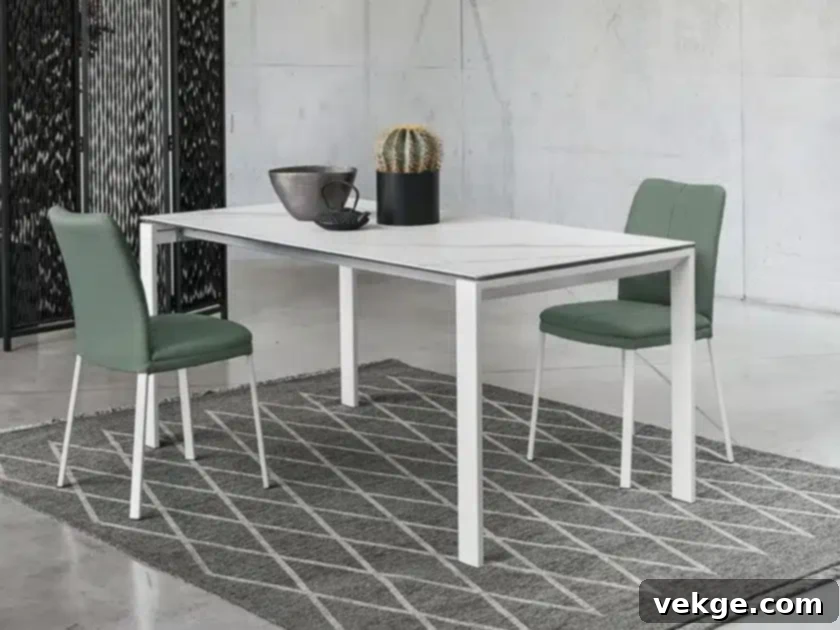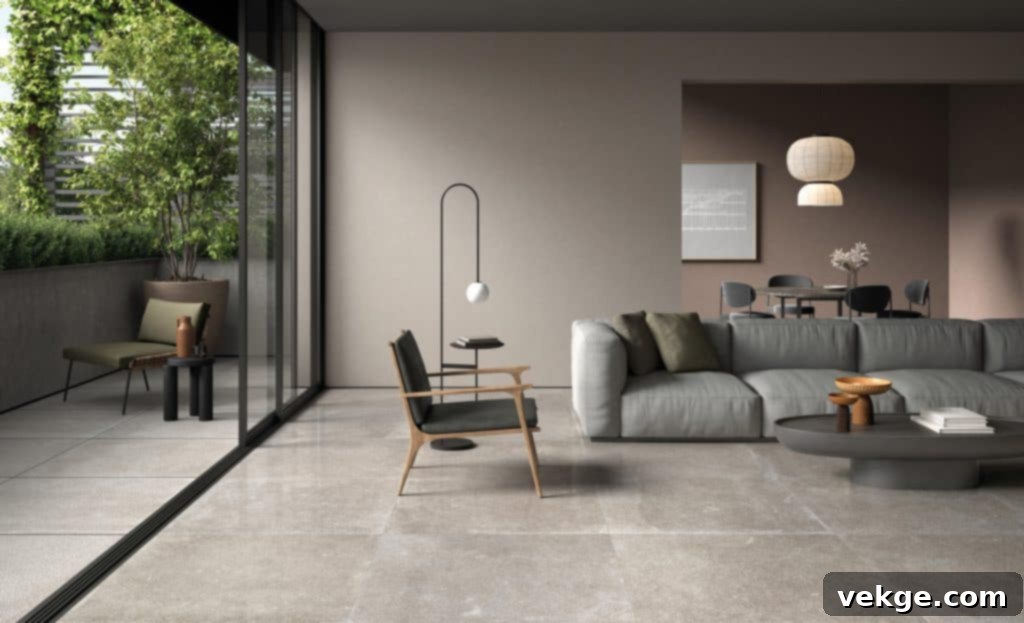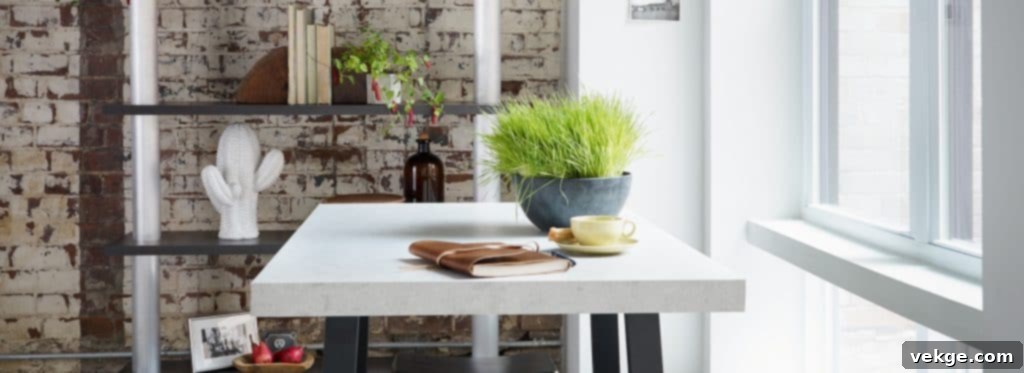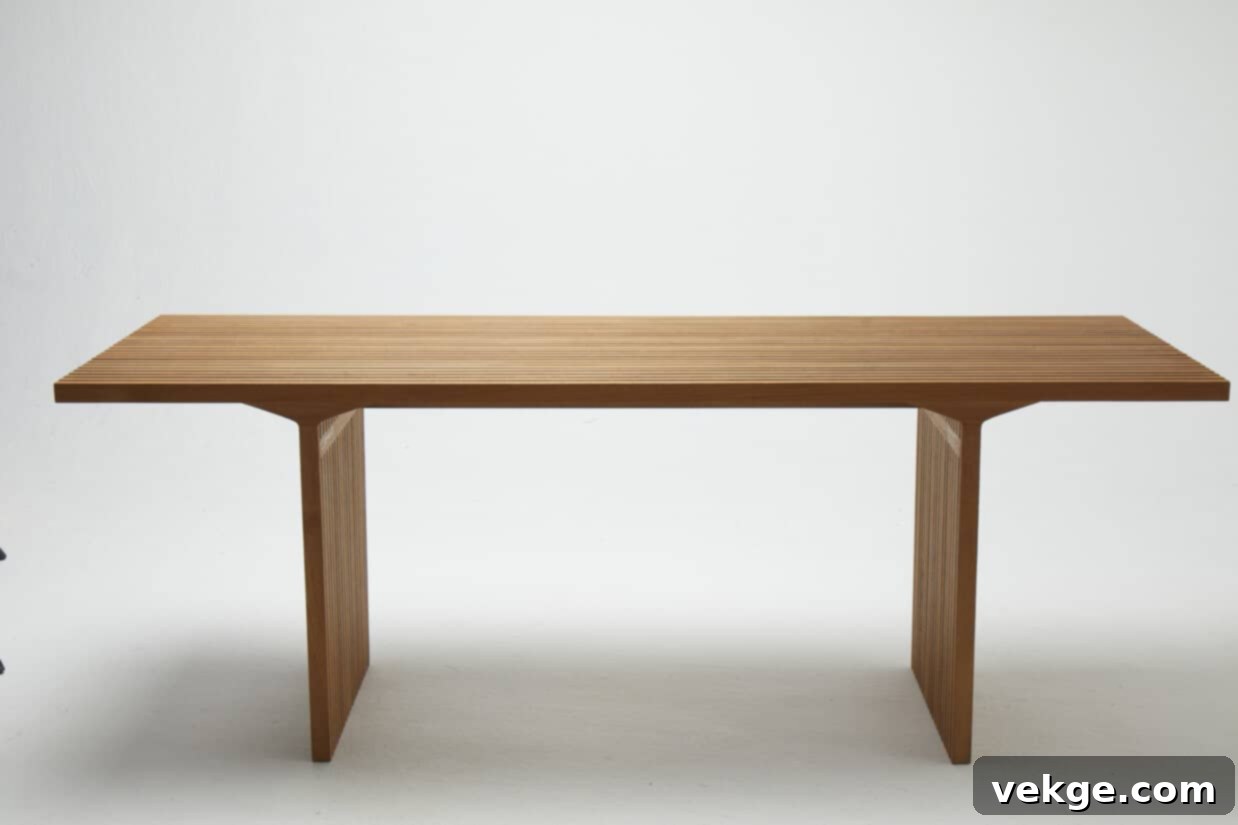The Enduring Allure of Ceramic Tables: A Deep Dive into Sustainable Craftsmanship and Modern Design
In the dynamic world of home décor and interior design, ceramic tables have swiftly ascended to prominence, embodying a perfect fusion of elegance, durability, and practical functionality. Far more than mere furniture, these exquisite pieces represent a sophisticated marriage of the ancient art of ceramics with cutting-edge modern design principles. They are not only robust surfaces for daily use but also striking, timeless artworks capable of elevating the aesthetic appeal of any living or working environment.
The growing demand for high-quality, sustainable, and aesthetically versatile furniture has placed ceramic tables at the forefront of contemporary design trends. Their unique properties, ranging from unparalleled resistance to scratches, heat, and stains, to their inherently hygienic and easy-to-clean surfaces, make them an ideal choice for discerning homeowners and design professionals alike. Furthermore, their diverse array of finishes and textures allows for seamless integration into various interior styles, from minimalist to luxurious.
This comprehensive article delves into the intricate and fascinating world of leading ceramic table manufacturers. We will explore the meticulous processes involved in their creation, from initial material selection to the final exquisite finish. We will also highlight the innovative designs that define these manufacturers’ collections, their unwavering commitment to sustainability, and the core values that drive their dedication to crafting these exceptional pieces. Join us as we uncover what makes ceramic tables a truly remarkable investment for any space.
The Evolution of Ceramic Table Manufacturing: From Ancient Roots to Modern Innovation
Historical Insights into Ceramic Craftsmanship

The illustrious tradition of ceramic craftsmanship is deeply rooted in human history, spanning thousands of years and evolving from rudimentary pottery used for utility into sophisticated items of art and furniture. This ancient legacy, characterized by a profound understanding of earth and fire, continues to inspire today’s ceramic table manufacturers. Modern ceramic tables, with their vast array of styles, intricate patterns, and diverse finishes, are a direct reflection of this rich history. They masterfully blend time-honored techniques, passed down through generations of artisans, with cutting-edge contemporary aesthetics, resulting in pieces that are both historically resonant and distinctly modern. This evolution underscores a continuous quest for beauty, functionality, and enduring quality, solidifying ceramic tables as a cornerstone in modern interior design.
Material Excellence and Sustainable Sourcing for Ceramic Furniture
At the core of every high-quality ceramic table is an unwavering commitment to material excellence and sustainable sourcing. Leading manufacturers understand that the intrinsic strength, aesthetic appeal, and longevity of their tables begin with the selection of the finest raw materials. This typically involves using high-grade clays, such as kaolin and feldspar, combined with carefully formulated glazes and pigments. These materials are chosen not only for their superior performance characteristics—including exceptional hardness, resistance to thermal shock, and non-porosity—but also for their environmental credentials.
Manufacturers prioritize establishing relationships with suppliers who adhere to strict environmental protection standards. This often means sourcing materials from ethically managed sites, minimizing transportation distances to reduce carbon footprint, and ensuring that extraction processes are responsible. Furthermore, glazes are often selected for their low volatile organic compound (VOC) content, contributing to better indoor air quality. This holistic approach to material selection and sourcing is paramount, ensuring that each ceramic table not only boasts unparalleled durability and beauty but also aligns seamlessly with broader ecological values and a commitment to a healthier planet.
From Initial Concept to Finished Ceramic Masterpiece

The journey of a ceramic table, from an abstract concept to a tangible, exquisite reality, is a testament to meticulous planning, creative vision, and precise execution. This complex process typically begins with a collaborative effort between visionary designers, skilled engineers, and experienced artisans. The initial spark of inspiration often stems from diverse sources: emerging interior design trends, the organic beauty of nature, specific cultural heritage, or even a client’s unique vision. This vision is then meticulously translated into detailed sketches, technical drawings, and often, sophisticated CAD (Computer-Aided Design) models. Prototyping allows for the refinement of shapes, proportions, and structural integrity.
Beyond aesthetics, a critical phase involves selecting the appropriate support structure and base materials, which can range from robust metals like stainless steel or powder-coated aluminum to natural hardwoods. This collaborative approach ensures that each ceramic table produced is not only a visually stunning piece of furniture but also robustly functional, ergonomically sound, and exceptionally resilient, designed to withstand the rigors of daily use while maintaining its inherent beauty.
Harmonizing Traditional Craft with Modern Ceramic Technologies
The manufacturing of ceramic tables epitomizes a delicate yet powerful dance between time-honored traditional craftsmanship and cutting-edge technological innovation. On one hand, skilled artisans continue to employ age-old techniques, preserving the human touch that imbues each ceramic piece with unique character. This includes intricate hand-carving, custom mold-making, and specialized glazing applications that create depth, texture, and bespoke visual effects. These artisanal methods ensure that no two tables are ever exactly alike, offering a distinct sense of individuality and heritage.
Concurrently, modern technologies are seamlessly integrated into the production process to enhance precision, efficiency, and consistency. Advanced machinery like CNC (Computer Numerical Control) cutting tools are used to achieve perfectly uniform ceramic slabs and intricate edge profiles. High-definition digital printing allows for the reproduction of complex patterns, natural stone appearances, and custom graphics with incredible fidelity. Automated, energy-efficient kilns ensure precise temperature control during firing, which is crucial for the material’s strength and glaze adhesion, while also minimizing environmental impact. Even innovative techniques like 3D ceramic printing are being explored to create novel, complex forms that would be impossible through traditional methods. This strategic blend of the manual and the mechanical allows ceramic table manufacturers to achieve unparalleled quality, durability, and design versatility.
A Spectrum of Designs: Crafting Aesthetic Versatility

The Allure of Customization in Ceramic Table Design
Recognizing the profound desire for personalized décor and unique interior statements, leading ceramic table manufacturers offer extensive customization options, transforming each table into a bespoke reflection of the owner’s taste. This flexibility allows customers to tailor their tables in myriad ways: choosing specific dimensions (from compact coffee tables to expansive dining surfaces), a diverse palette of colors, and a wide array of patterns and finishes. Whether seeking a polished, high-gloss surface that mimics marble, a textured matte finish reminiscent of concrete, or an intricate pattern inspired by natural elements, the possibilities are virtually limitless.
Beyond the ceramic top itself, customization often extends to the table’s base and legs. Clients can select from various materials like solid wood, sleek metal (e.g., brushed steel, black powder-coated aluminum), or even sculptural ceramic bases, each offering a distinct aesthetic and structural integrity. This level of personalization ensures that each ceramic table is not merely a piece of furniture but a carefully curated art object, making a powerful personal statement that perfectly complements its home environment and stands out as a focal point.
Exploring Signature Ceramic Table Collections
In addition to bespoke options, reputable ceramic table manufacturers proudly present a diverse array of signature collections, each meticulously designed to cater to distinct aesthetic preferences and interior settings. These collections are often born from extensive research into global design trends, architectural movements, and artistic inspirations, allowing manufacturers to offer curated choices that resonate with a broad audience.
For instance, some collections might feature sleek, minimalist designs, characterized by clean lines and monochromatic palettes, perfectly suited for contemporary or Scandinavian-inspired spaces where a sense of calm and uncluttered elegance is desired. Other collections might embrace bold, intricate patterns, vibrant colors, or unique textural finishes, transforming the table into a striking focal point in more eclectic or luxurious settings. Manufacturers often develop collections that simulate natural materials like marble, granite, or wood, providing the aesthetic appeal of these materials with the superior durability and maintenance benefits of ceramic. Each signature collection is a narrative in itself, offering a curated design language that allows homeowners and designers to select pieces that tell their desired story within a space, from understated sophistication to dramatic artistic expression.
Commitment to Sustainability and Ethical Manufacturing Practices

Pioneering Eco-conscious Manufacturing of Ceramic Furniture
In an increasingly environmentally conscious era, leading ceramic table manufacturers are distinguishing themselves through a steadfast commitment to pioneering sustainable practices. Their dedication extends throughout the entire production lifecycle, aiming to minimize ecological impact while upholding superior quality. This commitment encompasses several key areas:
- Recyclable Materials: Utilizing raw materials that are abundant and, where possible, incorporating recycled content into their ceramic compositions or table bases. The ceramic itself is a naturally inert material, and post-consumer waste can often be re-integrated into the production cycle for certain applications.
- Waste Reduction: Implementing lean manufacturing principles to significantly reduce waste generation. This includes optimizing cutting patterns, recycling water in closed-loop systems, and finding innovative uses for by-products.
- Energy-Efficient Production: Investing in state-of-the-art kilns and machinery that consume less energy, often powered by renewable sources. Optimizing firing cycles and heat recovery systems further contributes to a reduced carbon footprint.
- Longevity and Durability: By producing exceptionally durable tables designed to last for decades, manufacturers inherently reduce the demand for frequent replacements, thereby minimizing resource consumption and landfill waste associated with fast furniture trends.
- Low VOCs: Ensuring that glazes and adhesives used in assembly are low in volatile organic compounds (VOCs), contributing to healthier indoor air quality for both manufacturing employees and end-users.
This comprehensive approach to eco-conscious manufacturing not only protects the environment but also provides consumers with a product they can feel good about owning.
Upholding Social Responsibility and Supporting Local Communities
The commitment of leading ceramic table manufacturers extends far beyond environmental stewardship to encompass a robust sense of social responsibility. Many prioritize engaging with local communities, recognizing the invaluable role they play in the unique character and success of their products. This emphasis on social ethics translates into several key practices:
- Preserving Artisan Skills: By employing local artisans and skilled craftspeople, manufacturers help preserve traditional techniques and knowledge, ensuring that these invaluable skills are passed down through generations. This connection to heritage adds cultural authenticity and depth to each piece.
- Fair Labor Practices: Adherence to stringent fair labor practices is non-negotiable. This includes providing safe working conditions, fair wages, reasonable working hours, and opportunities for professional development for all employees. Ethical sourcing extends to ensuring that supply chains are free from exploitation.
- Economic Development: Investing in local economies through job creation, sourcing local materials (when feasible), and collaborating with local businesses contributes significantly to community well-being and fosters sustainable economic growth in the regions where manufacturers operate.
- Community Engagement: Many manufacturers actively participate in local initiatives, supporting educational programs, cultural events, or environmental protection projects, thereby giving back to the communities that support their operations.
This holistic commitment to both environmental and social ethics ensures that when you choose a ceramic table from a responsible manufacturer, you are not only acquiring a beautiful and durable piece of furniture but also supporting a business model rooted in integrity and positive societal impact.
Care and Maintenance for Enduring Ceramic Table Beauty

Ensuring the Longevity and Pristine Condition of Your Ceramic Table
One of the most celebrated attributes of ceramic tables is their exceptional durability and resistance to everyday wear and tear. Their non-porous surface makes them highly resistant to stains, heat, and scratches, significantly reducing the maintenance typically associated with other furniture materials. However, to truly preserve their pristine beauty and ensure they remain a cherished centerpiece in your home for generations, a few simple care practices are recommended.
Leading manufacturers provide detailed guidance to help owners maintain their ceramic tables. Generally, routine cleaning involves simply wiping the surface with a damp cloth and mild detergent. Abrasive cleaners, steel wool, or harsh chemicals should be avoided, as these can dull the finish over time. For tougher stains, specific ceramic cleaning products are often recommended. While ceramic is incredibly robust, it’s always wise to use coasters for extremely hot dishes and placemats, especially for items with abrasive undersides, to prevent any potential microscopic wear over prolonged periods. Following these straightforward care instructions ensures that the inherent elegance and functional integrity of your ceramic table will endure, making it a truly lasting investment.
Why Ceramic Tables Are the Ultimate Choice for Modern Living
Unrivaled Unique Selling Points of Ceramic Tables
In a market saturated with furniture options, ceramic tables stand out with a compelling array of unique selling points that make them an unparalleled choice for any discerning homeowner or interior designer. Their distinct blend of functionality, enduring beauty, and inherent sustainability positions them as a superior investment. Here’s a closer look at what truly sets them apart:
- Exceptional Durability: Ceramic surfaces are renowned for being incredibly hard and non-porous, making them highly resistant to scratches, impacts, and daily wear. They are also impermeable to liquids, preventing stains from common spills like wine, coffee, or oil.
- Heat and UV Resistance: Unlike many other materials, ceramic can withstand high temperatures without scorching or disfiguring, making them ideal for dining and kitchen areas. Furthermore, they are UV resistant, ensuring their colors and patterns won’t fade even with prolonged exposure to sunlight, making them suitable for bright indoor spaces or even covered outdoor areas.
- Hygienic and Easy to Clean: The non-porous nature of ceramic means it does not harbor bacteria, mold, or mildew, making it an exceptionally hygienic surface—a crucial benefit for dining and food preparation areas. Cleaning is effortless, usually requiring just a damp cloth and mild soap.
- Aesthetic Versatility: With advancements in ceramic manufacturing, these tables can convincingly replicate the look and feel of natural stone (like marble or granite), wood, concrete, or even abstract artistic patterns, offering boundless design possibilities to match any decor style.
- Sustainable Investment: As discussed, many manufacturers prioritize eco-friendly production, and the extreme longevity of ceramic tables means fewer replacements over time, reducing overall consumption and waste. They are truly designed to be heirloom pieces.
- Timeless Elegance: Ceramic tables possess an innate elegance that transcends fleeting trends. They are designed to be focal points, embodying sophistication and an artistic flair that enhances any room.
These combined attributes elevate ceramic tables beyond mere furniture, transforming them into valuable heirlooms that embody the essence of masterful craftsmanship, innovative design, and practical luxury.
Insights from Satisfied Customers and Design Collaborations
The true measure of a product’s quality and appeal is often found in the experiences of its users and the endorsements of industry professionals. Ceramic tables consistently receive glowing reviews from satisfied customers who frequently praise their durability, ease of maintenance, and sophisticated appearance. Homeowners often highlight how these tables effortlessly withstand the demands of family life, maintaining their pristine condition for years, and become central pieces for gatherings and daily activities.
Beyond individual consumers, the versatility and robust performance of ceramic tables have made them a preferred choice for collaborations with renowned interior designers, architects, and hospitality professionals. These partnerships are instrumental in extending the reach of ceramic tables into high-end residential projects, luxurious commercial spaces, and stylish public environments. The ability to customize sizes, finishes, and integrate them seamlessly into diverse design schemes makes ceramic an invaluable material for professional specifiers. Such collaborations not only validate the superior quality and aesthetic flexibility of ceramic tables but also underscore their adaptability and widespread appeal across various demanding and aesthetically driven settings.
Conclusion: Embracing a World of Enduring Elegance and Sustainability with Ceramic Tables
In conclusion, the journey through the world of ceramic table manufacturers reveals a profound dedication that extends far beyond mere furniture production. These artisans and innovators are, in essence, crafting pieces of functional art that embody a deep-seated commitment to unparalleled quality, environmental sustainability, and ethical production practices. From the careful selection of raw materials and the harmonious blend of traditional craftsmanship with advanced technology, to the offering of a vast spectrum of customizable designs, every step in the manufacturing process is infused with passion and precision.
Choosing a ceramic table for your home or project is more than just a purchase; it is a conscious investment in a piece that promises timeless elegance, exceptional durability, and remarkable versatility. It’s an investment in a surface that will resist the rigors of daily life—scratches, heat, and stains—while maintaining its pristine beauty for decades. Furthermore, by opting for a ceramic table from a reputable manufacturer, you are actively supporting responsible manufacturing practices that prioritize ecological stewardship and social well-being.
As the appreciation for both sophisticated design and sustainable living continues to grow, the future of ceramic tables shines brighter than ever. We can anticipate even greater innovations in design, material science, and manufacturing techniques, promising new forms, textures, and applications that will continue to inspire, enchant, and enrich our living spaces. Ceramic tables truly represent the pinnacle of modern furniture, offering a perfect blend of aesthetic appeal, robust performance, and a clear conscience.
